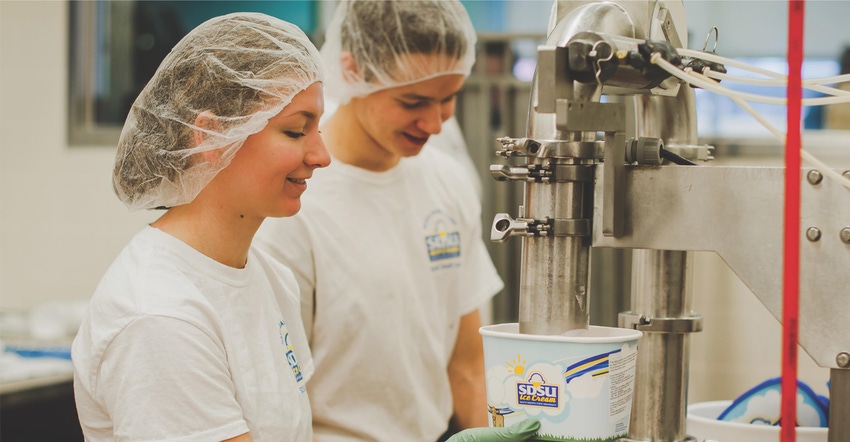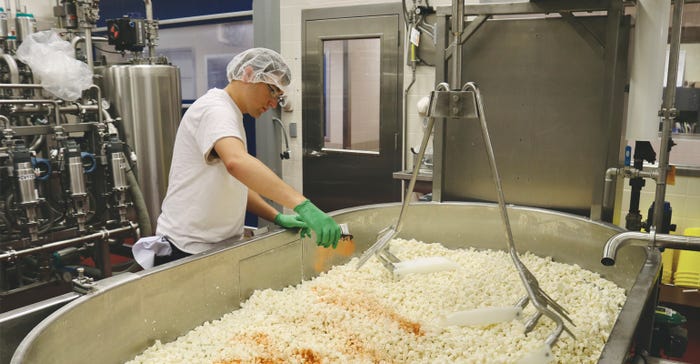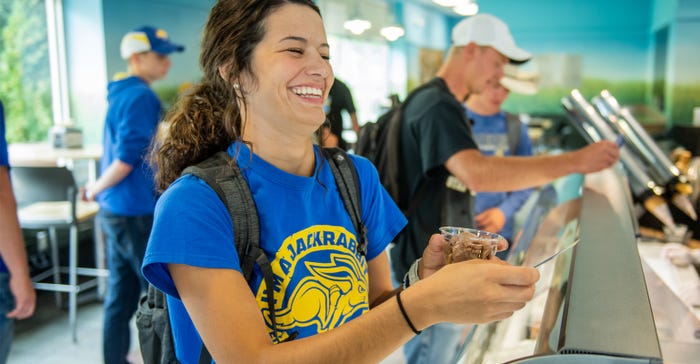
Imagine leaving college with four years of practical work experience under your belt, giving you an advantage over your fellow graduates.
Lane Speirs, coordinator of recruitment and academic services for Dairy and Food Science at South Dakota State University, believes students majoring in dairy production or dairy manufacturing at SDSU can gain practical experience on top of what they learn in the classroom.
While SDSU has had a dairy program since its beginnings over 130 years ago, the current Davis Dairy Plant, which opened in 2011, sits at the core of this hands-on learning experience. Students can gain real-life experience in a dairy processing facility.
“The time students get to spend working and researching in the Davis Dairy Plant gives them a holistic understanding of what they will see in a full-size dairy plant after graduation,” Speirs says. “In terms of size and capability, the Davis Dairy Plant is one of the best campus dairy manufacturing plants in the country.”
Other than plant manager John Haberkorn and assistant manager Akimoto Ichinomiya, the plant is operated by SDSU students, and Speirs says that job placement in the plant is guaranteed to students in dairy or food science majors. This is where the practical experience comes in, as a graduating senior could have four years of experience working in the dairy plant if they started as a freshman.

Not only is the plant used to weekly process 15,000 to 17,000 pounds of milk from the SDSU Dairy Research and Training Facility to be turned into cheese, butter and ice cream, but it is also home to a variety of research projects. Speirs says internal projects are conducted by faculty and graduate students, while external research projects are those conducted by industry partners or members of the dairy industry wishing to perform trials.
Speirs says these external research projects expose the student-workers to industry leaders and vice versa. “Since the Davis Dairy Plant has all of the necessary equipment and capabilities of a full-size plant, but on a smaller scale, companies are able to save a significant amount of money on the product used in their research by renting our campus facilities and conducting their research here,” he says. “The other cool part is our students are in the plant working with them, helping them with that research. So these companies get to see the students in action and work side by side with them even before they graduate.”
The ability for students to work alongside dairy manufacturing professionals, as well those students able to potentially gain four years of plant experience add up to the 100% job placement for SDSU dairy science students upon graduation.
“It really helps that students are able to work alongside industry professionals in the plant, and the industry professionals get to know the students as well,” Speirs says. “A big part of that 100% job placement is due to the fact that our students are so well-prepared upon graduation.”
Cow-to-cone program
SDSU dairy students get involved in the entire process, in what Speirs calls the “cow-to-cone” program. Undergraduates get involved at every level in the milk chain, from milking the 120 to 130 Holsteins and 30 Brown Swiss cows at the Dairy Research and Training Facility, to working in the Davis Dairy Plant, to the marketing and retailing of the variety of dairy products.
A popular stop on campus for returning alumni or prospective students on a tour is the Dairy Bar, where consumers can buy items produced next door in the Davis Dairy Plant. In addition to a variety of cheeses and butter, visitors can find 18 of the more than 60 ice cream flavors available on any given day. The Dairy Bar is operated by Aramark Dining Services of SDSU.

On top of helping process the flavors, Speirs says students also can develop a student edition cheese, seeing it through from the idea stage to blocks of cheese in the case sold at the Dairy Bar.
Creativity can be endless when developing new flavors of cheeses and ice cream, and you just never know when you might hit upon something big. That happened back in the 1970s, when Shirley Seas, dairy plant manager at the time, and dairy science students Joe Leedom and Joe Van Treeck invented Oreo ice cream, which would come to be known as the ever-popular Cookies ’n’ Cream.
Other flavors have been created to pay homage to people, places and events, from Barry Berry named for then Dean of College of Agriculture and Biological Sciences Barry Dunn to Hobo Crunch for the annual “homecoming” event to Campanile Crunch that was created for the 125th anniversary of SDSU.
From exposure to a state-of-the-art dairy processing plant to aligning students with industry leaders for the future to the production of creative popular flavors of cheeses and ice cream, the SDSU dairy program prepares students for a dairy career. Those efforts have been noticed, as University.com recently put SDSU at the No. 2 spot of the best dairy science colleges in the United States for 2021, behind only the University of Wisconsin-Madison.
About the Author(s)
You May Also Like






